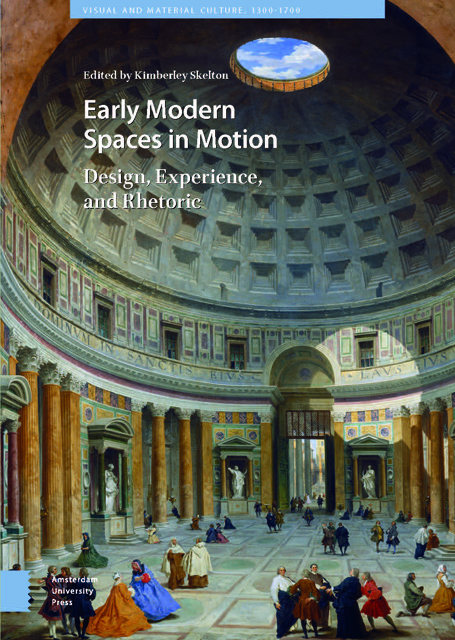Book contents
- Frontmatter
- Table of Contents
- List of Illustrations
- Acknowledgements
- Introduction: Bodies and Buildings in Motion
- 1 Navigating the Palace Underworld : Recreational Space, Pleasure, and Release at the Castello del Buonconsiglio, Trent
- 2 Passages to Fantasy : The Performance of Motion in Celliniâs Fontainebleau Portal and the Galerie François I
- 3 The Catholic Country House in Early Modern England : Motion, Pietyand Hospitality, c. 1580â1640
- 4 Sensory Vibrations and Social Reform at San Michele a Ripa in Rome
- 5 The Rise of the Staircase: Motion in Eighteenth-Century Dutch Domestic Architecture
- 6 Movement through Ruins: Re-experiencing Ancient Baalbek with Jean de la Roque
- 7 A Paper Tour of the Metropolis : The Architecture of Early Modern London in the Royal Magazine
- 8 Libraries in Motion: Forms of Movement in the Early Modern Library (1450-1770)
- Works Cited
- Index
8 - Libraries in Motion: Forms of Movement in the Early Modern Library (1450-1770)
Published online by Cambridge University Press: 11 January 2023
- Frontmatter
- Table of Contents
- List of Illustrations
- Acknowledgements
- Introduction: Bodies and Buildings in Motion
- 1 Navigating the Palace Underworld : Recreational Space, Pleasure, and Release at the Castello del Buonconsiglio, Trent
- 2 Passages to Fantasy : The Performance of Motion in Celliniâs Fontainebleau Portal and the Galerie François I
- 3 The Catholic Country House in Early Modern England : Motion, Pietyand Hospitality, c. 1580â1640
- 4 Sensory Vibrations and Social Reform at San Michele a Ripa in Rome
- 5 The Rise of the Staircase: Motion in Eighteenth-Century Dutch Domestic Architecture
- 6 Movement through Ruins: Re-experiencing Ancient Baalbek with Jean de la Roque
- 7 A Paper Tour of the Metropolis : The Architecture of Early Modern London in the Royal Magazine
- 8 Libraries in Motion: Forms of Movement in the Early Modern Library (1450-1770)
- Works Cited
- Index
Summary
Abstract
Libraries are usually thought of as quiet, still spaces and imagined empty. This chapter takes the opportunity to re-examine the library as a space by looking at how it physically altered in the early modern period with the advent of printing and the changes that this brought about. It looks at the types of movement encountered in the library setting: the movements of people (librarians, visitors, readers), books (including their chains and security), and library fittings (of shelves, ladders, and secret doors) in an attempt to show libraries in a new light, quite often empty but, when used, full of movement in unexpected and interesting ways.
Keywords: library books, shelving, libraries, readers, librarians
This chapter looks at movement in a particular architectural space. The library brings up all sorts of questions when we consider it in terms of movement. The first and perhaps most important is: what do we mean when we talk about discussing movement in a space? There are many possibilities, and this chapter will attempt to explore some of them, although no doubt the reader will be able to think of even more. The question of the extent to which those moving through the spaces at the time considered themselves in motion and reflected upon it in those terms is not so easy to discern, and inevitably this paper is exploring what might have been the case from the limited evidence available. However, the project is not without any foundation: the library itself changed dramatically in layout in the early modern period, and this gives us an opportunity to discuss how those changes must have affected movement with some certainty.
Libraries
Before looking at the specific issue of movement, it is perhaps worth briefly addressing what we mean by a library. In this period, the library was almost never a freestanding building, but rather a room in a larger institution. The extent to which this room was ‘designed’ will, as we shall see, vary greatly across the period. The library was almost never conceived by a single individual The room itself was usually built and set out by an architect or stonemason, while the fittings were pieces of furniture that were added or fitted in by joiners or cabinetmakers.
- Type
- Chapter
- Information
- Early Modern Spaces in MotionDesign, Experience and Rhetoric, pp. 211 - 236Publisher: Amsterdam University PressPrint publication year: 2020

